Vince Young's journey north to rewrite the ending of his football career

Vince Young is here, of all places, at this moment, in the city of Saskatoon, in the Canadian province of Saskatchewan, where vivid summer storms dance across endlessly flat horizons. The Land of the Living Skies. It’s late May, and he’s relaxing on a polyester couch inside a dorm room at a local university. This is an alternate football universe, a land of jarring juxtapositions.
Eleven years removed from winning the national championship at Texas, 40 months after he filed for bankruptcy, Young spends his nights in Birch Hall, collapsing after long workouts onto a twin bed. He’s attempting to return to the sport that once defined him, that made him rich, that opened him up to ridicule and that ultimately crushed him. And that comeback starts in the Canadian Football League, where he’s a backup quarterback for the Saskatchewan Roughriders. At least for now.
I flew north to meet with Young after speaking to two dozen of his closest friends and family members this spring. They’d offered varied theories about why he’d returned to football after a three-year absence, motives that ranged from simplistic (he hated how his career had ended, released by the Browns) to optimistic (he dreamed of an NFL return) to skeptical (he’d recently partnered in three businesses; each would benefit from the publicity).
Young unwraps a Subway panini in the common area adjoining his bedroom. The space is empty of belongings, except for jars of peanut butter and jelly, a package of Ritz crackers, clothes and a playbook. He is 2,000 miles from home, surrounded by teammates who, by and large, ventured to Canada after failing elsewhere. Practices are sparingly attended—80 fans dotting metal bleachers, no security, no deejay spinning tunes.
At 34, Young is no longer the phenom, no longer the man known as Invinceable. His new teammates call him Graybeard. I ask him how he’d react if this experiment ended badly, if he played out the season as a backup. Or worse: if it all failed. “This is to finish my career on my note,” he says. “Before, the NFL shut me down. Teams shut me down. Owners shut me down. I didn’t stop because I wanted to. Now, I can’t blame anyone but me.”
For his last birthday, in May, Young chose a low-key celebration in Austin, watching the NBA playoffs with friends. That fit with the narrative he’s pushing: perspective gained, pounds shed. . . . He’s here, on Memorial Day, when he could be back home, barbecuing with the millionaire UT boosters he counts as mentors, hanging out with his wife, Candice, and their six-year-old son, Jordan.
In Austin, Young is still the celebrity deemed by his Longhorns coach, Mack Brown, “obviously one of the best to ever play college football.” He’s still the guy the Titans plucked with the No. 3 pick in 2006, who won Offensive Rookie of the Year, reached two Pro Bowls and went 31–19 as an NFL starter. He’s still a friend to Snoop Dogg, Oprah, Matthew McConaughey, Jamie Foxx. No one can take any of that away from him. The problem is, that’s only half his story. The good half. He’s here, he says, to rewrite the ending, to close the disconnect between celebrity and ignominy, between rich and broke, scorned and reborn, to lift now closer to back then.
How Allen Iverson finally found his way home
The more Young talks, though, the less clear it is how far along he is in this transformation. Occasionally he sounds like the young man some of his old coaches describe as lacking self-awareness, as when he explains that he’s applied to trademark the phrase Make Vince Great Again. He says he sent a text message to the pregnant Serena Williams joking about how “that should be my baby.” Even when he exposes his vulnerabilities, revealing that he’s barely watched any football since he retired, he can’t help but say, “I’d see a quarterback and be like, Dude is garbage, and I’m over here in the kitchen cooking turkey necks!?” He’s reminded that the Cardinals recently signed Blaine Gabbert, a first-round failure who never achieved Young’s success, and he pounces: “Exactly. I hate to name-drop, but [Ryan] Fitzpatrick is still playing!? He leads the league in interceptions, and he’s still f------ getting paid? I mean, what the f--- is going on?” (Fitzpatrick was third in picks last year, but Young has a point.)
He goes back and forth; he is changed and unchanged, humbled and entitled, forgiving and irate, accountable until he casts blame in myriad directions. He is, like most people, full of contradictions. It’s as if he’s still working through the five stages of grief over the way his NFL career ended: He’s no longer in denial, but he’s still somewhat angry. Somewhere down the line, he hopes, lies acceptance.
“This is all about where I was,” he says, “and where I want to be.”
Two weeks later, the experiment will be over.
Fifteen years before this comeback Young settled into another dorm room, this one on Texas’s campus. He joined a community leadership program, Longhorn Leaders, that had him visiting the worst neighborhoods in Austin. There he would share his story of growing up in Houston: abandoned by his father; cared for by a mother, Felicia, who struggled with drugs and alcohol; surviving at times without running water or electricity.
Even then, Young wanted to control his narrative, inspire kids. “He didn’t want to make the mistakes his parents made,” says Selvin Young (no relation), Vince’s running back for three years in Austin. “He wanted to separate himself from failure.”
Young redshirted and then became, in succession, the Longhorns’ starter, a star and, as a junior, one of the best players in the country. He engineered so many comebacks that they became his signature. At 6' 5" and 230 pounds, he displayed athleticism that defied physics—but so did his throwing motion, that awkward hitch leading to near-sidearm throws.
As Young’s celebrity skyrocketed, he found a mentor in Steve McNair, an NFL star with a sterling reputation. Texas and USC, both undefeated, met in the Rose Bowl for the national title on Jan. 4, 2006, and McNair sat in the stands with the Longhorns fans, watching as the Trojans took a 38–26 lead with 6:42 remaining. (Further setting the stage: A month earlier Young had lost to USC’s Reggie Bush in the Heisman race, after which Young retreated to his hotel room and refused to come out.) In Pasadena, McNair borrowed a cowboy hat for good luck from the child sitting in front of him, and with the game almost over he turned to a close friend and predicted, “This story has been written, and it’s not going to end any other way.”
• Read the best of Sports Illustrated’s Where Are They Now? stories
Young proved his mentor clairvoyant. He ran in one score with 4:03 left, then steered the Longhorns down the field in the final two minutes. On fourth-and-five, with 26 seconds remaining, he bounded into the end zone to secure a permanent spot in college football lore. Many described Young’s performance—200 yards rushing, 267 passing and three TDs, including the walk-off TD in a 41–38 national title win—as the single greatest in the history of the sport.
In the immediate aftermath Felicia couldn’t get near her son. He had ascended to a new level of fame overnight. She watched fans cry, begging for his autograph. She worried about the celebrity tsunami, her son’s new friends, the relatives—more like “relatives”—circling with their hands out. “It was hysterical,” Felicia says. “We couldn’t go out to eat. He couldn’t go to the restroom without being bombarded.”
A week later Vince declared for the NFL draft, having racked up 30 victories in 32 starts, a .938 winning percentage that ranked sixth in D-I history. “I figured he’d play 13 or 14 NFL seasons,” says Greg Davis, his college coordinator. “No one was more surprised than me how that all worked out.”
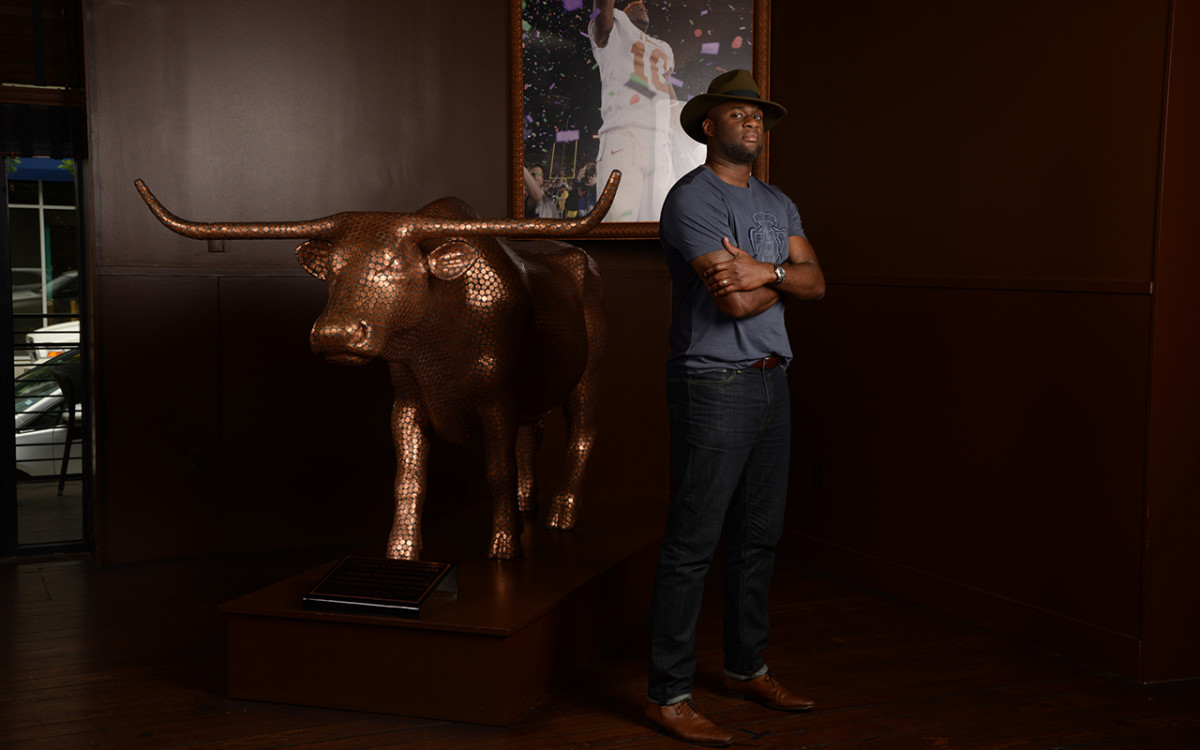
The people closest to Young care less about why he went to Canada—the real story, as they see it, is how he made it back. They knew he’d been burned by fame, and as they saw him pull his life together, they wondered, Did he have any magic left?
Young’s squandered-potential story contains many familiar missteps, but so much of what hindered him was also beyond his control, starting with the 2006 draft. As selection day approached, the QB-needy Titans ran Young, USC’s Matt Leinart and Vanderbilt’s Jay Cutler through the same routine, convening over the same steak dinners, quizzing them on the same plays. “Everyone felt Vince was the third of the three,” says Norm Chow, then Tennessee’s offensive coordinator, “but there was something about the owner.”
That owner, Bud Adams, told his staff which quarterback the team would select: the one who, like Adams, had roots in Houston. Young would have preferred to play for his hometown Texans, but they used the No. 1 pick on defensive end Mario Williams. Bush went next to the Saints. Tennessee then took Young, against the wishes of coach Jeff Fisher. “Their relationship was off from the get-go,” says Bo Scaife, a former Longhorn and Titan who’s one of Young’s best friends.
Quarterback and coach played nice at first; Fisher, a USC alum, told the Houston Chronicle, “at heart, we’re all fans [of Young].” But it proved difficult to square the guy who early on earned the cover of the Madden video game with the improvements his actual game required. Rather than reshape the callow QB, Chow sought to maximize his gifts, limiting his reads and letting him run. Chow wanted Young to be himself, hitch and all. “Vince just ran by people,” he says. “He has the most amazing feet a quarterback has ever had.”
The Titans started 2006 with three losses behind veteran Kerry Collins, at which point Fisher called Young to say he was handing him “the keys to the Hummer.” Young was confused. He was getting a car?
Chow liked Young but also found him immature. One day he’d sit up front in meetings, hand raised, asking questions. The next day he’d sit in the back, a baseball cap pulled low over his eyes. Once, Chow and Collins teased Young about his surly demeanor. In response Young reminded them he was “the only guy in this room” with the owner’s phone number. “Obviously, he had been spoiled,” Chow says. “He wasn’t willing to put in that extra study that sets quarterbacks apart. He didn’t lean on Kerry. He wasn’t a bad guy—heck, he was 23 years old. He was . . . pampered, coddled, whatever word you want to use.”
Young went 8–5 as a rookie starter and galloped 39 yards into the end zone in Houston, sticking it to the Texans in overtime that December. But his relationship with Fisher began to deteriorate during the following off-season, when Chow was fired. A decade later the quarterback tries to sidestep questions about his old coach, saying, “I don’t want to get into it” and “I’m saving that for my book.”
But Young can’t help himself. He may believe he’s moved on from what transpired in Tennessee, but broach the subject, and he appears angry, conflicted. “I’m going to expose his ass,” he says of Fisher, who he claims stripped all the fun from football, pushing Young until he broke. Whereas Brown had been the father figure Young always wanted, Fisher, he says, acted like someone saddled with an unwanted stepson. Family members, close friends, even Young’s pastor describe Fisher as “jealous” and “envious” of the QB.
Young recounts closed-door meetings with Fisher in which both men agreed to keep their conversation private; the next day, he says, he’d read Fisher’s side—his exact words—in the local papers. Young says he would sometimes arrive early for a meeting, only to learn it had been canceled, unannounced, and that the coach was out fishing with Collins. (Neither Fisher nor Collins responded to multiple emails, phone calls and texts from SI.)
Young describes an incident from November of his rookie season when he left his ID at home before a road game against the Eagles. As he tells it, he went to retrieve it and was then held up by a funeral procession en route to the team plane, so he called Fisher to say he would be two minutes late. Young had seen Fisher hold the plane for other players, but this time he did not. “I feel like Fisher did that s--- on purpose,” he says. “I’m pulling in, seeing them pull the door down. I can hear the team yelling.” As Young stood on the tarmac, grounded, he could only watch as the team he was supposed to lift into the playoffs soared into the sky without him.
At McNair’s urging, Young chartered a private jet to Philly instead. In his defense Fisher cited team policy for not waiting. Young wasn’t having it. “Where I’m from,” he told the coach, “that’s like saying F you.”
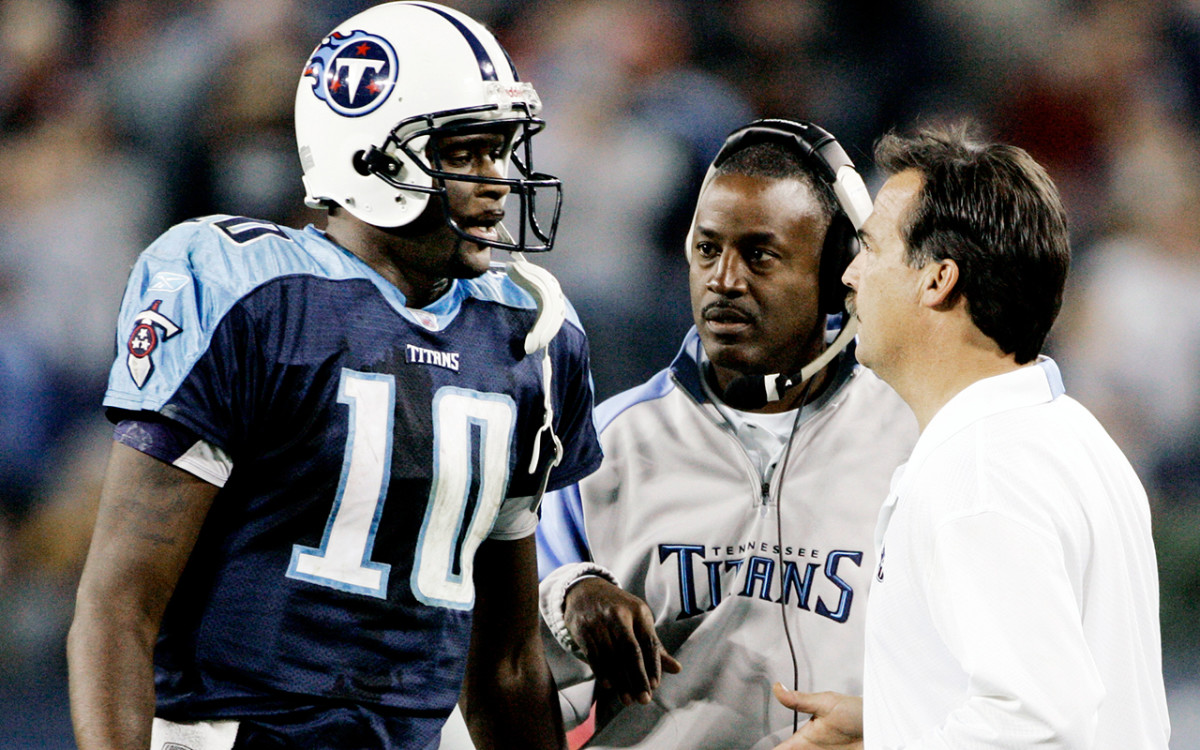
With palpable frustration, Young refers to the event that finally unraveled his relationship with Fisher (and marked the next step on his path toward Canada) as “the suicide incident.” It’s hard to forget that day, even if he wants to: the breathless news reports, the endless speculation, the white-Bronco-chase feel of it all. It’s easy for Young to look back and conclude that a single event marred his reputation. At the time, though, he just wondered if he was cursed.
It started in the 2008 season opener, when the home crowd booed Young for tossing two interceptions in a 17–10 win over the Jaguars. He strained the MCL in his left knee that afternoon and argued with Fisher on the sideline. The next day, instead of going to the facility for a medical exam, he left his house in a huff, carrying his gun—he was licensed and says he carried a firearm everywhere—but not his cellphone. Felicia was worried enough that she called the Titans. Fisher, Young says, phoned both the team therapist and the Nashville police.
The incident spiraled from there. Young and Scaife both say they’d simply gone out for chicken wings, to decompress. Young’s gun was locked in his glove box, unloaded. Fisher eventually reached Young through Scaife and asked that he return to the facility, but when he did, Young says, eight police officers and a negotiator were waiting for him.
They asked for his wallet and keys. Young sat down with the negotiator. “He’s talking all slowly,” the QB recalls, “like: ‘Mr. Young . . . are you . . . O.K.? Do you . . . feel like . . . hurting yourself?’ ”
“I’m like, Dude, quit talking to me! And I’m looking at Fisher like, You can stop all this, all the suicidal talk. He’s sitting there, saying nothing. I feel like he was just laughing at that s---. The [TV] cameraman hiding in the woods—it all felt like a big setup. And now I gotta walk through the airport as the Suicidal Guy for the rest of my life.”
How the present-day Warriors rekindled a franchise legend's love of the game
With Young shelved at first by his knee injury, Collins and the Titans went 13–3 that season. Young attempted a mere 36 passes in three games and took off for Cancún soon after the season ended, eager to forget 2008 forever. Upon landing, a friend called. “Pop’s gone,” the friend said, referencing McNair by his nickname. “He’s dead.”
The death of his mentor, shot by a 20-year-old girlfriend, shattered Young. “I felt like everything was going downhill for me,” he says. “Like I was all f------ alone.”
Young would earn the league’s Comeback Player of the Year honors in 2009 by taking over the 0–6 Titans and leading them to an 8–8 finish. But any progress with Fisher was temporary. In Week 11 the following season, at home against the Redskins, Young tore the flexor tendon in his right thumb. When Fisher refused to put the QB back in, he threw his shoulder pads and helmet, chucked his jersey into the stands and stalked into the locker room. As Young prepared to leave the stadium, Fisher tried to stop him. “You’re walking out on your team,” he said.
“I’m walking out on your motherf------ ass,” Young yelled back.
Fisher banned him from team meetings the following week. Young never again played for the Titans, who in turn fired Fisher that spring. (Adams would run the team until his death in 2013.)
Years later, Young says he sent Fisher a letter, apologizing for his immaturity, lamenting what might have been. Fisher never responded, and Young still vacillates between shouldering and assigning blame. He says, “I forgive him” and “I still regret it.” He also says, “I guess he doesn’t give two s---- about me.”
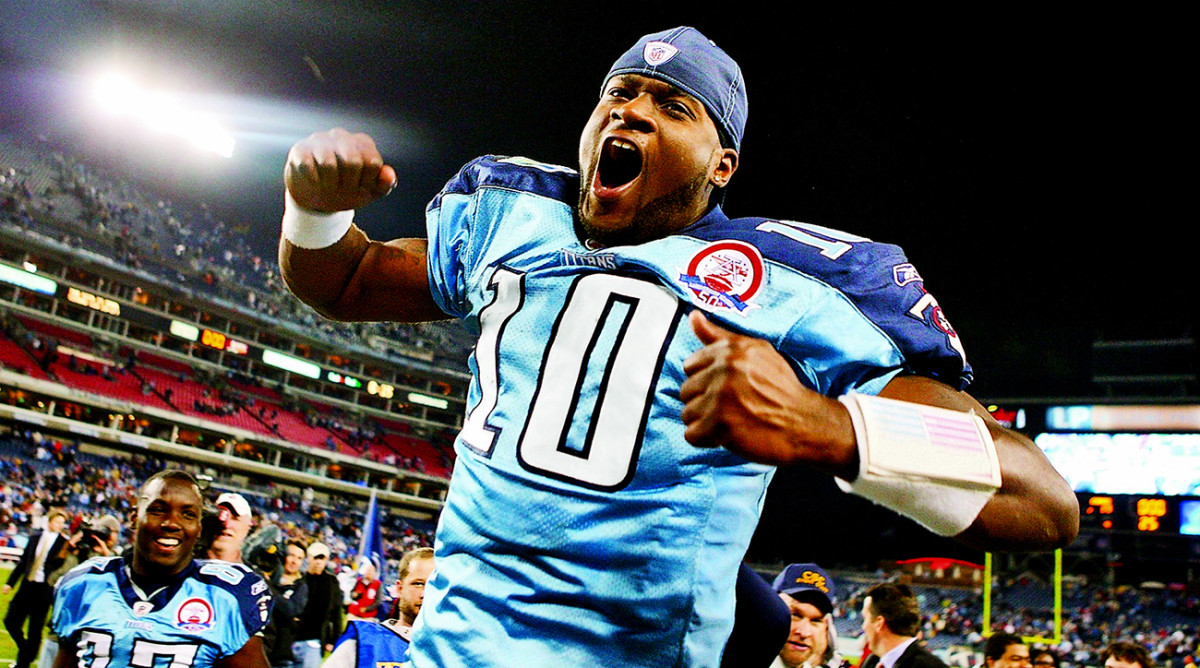
After a three-game stint with the Eagles and then training camp one-offs with the Bills and the Packers, Young was released in May 2014 by the Browns, who’d just drafted another Texan doomed to be swallowed by celebrity, Johnny Manziel. That Young didn’t get the news directly from Cleveland’s general manager or coach crystallized how far he’d tumbled, but he surprised even himself when the word retire came out of his mouth that June. Mostly he needed a break, and so he hopped a plane to visit Shawn Abboud, a friend and mentor who ran a hedge fund in Dubai.
There Young bunked in a hotel for 10 days. Abboud scheduled meetings for him with entrepreneurs, executives, members of the royal family, startup CEOs and high-powered lawyers. Young sat with Abboud at the trading desk and listened to his phone calls. He filled two notebooks with ideas and came away with a sense of what he might be able to accomplish outside the game that spurned him. “He was sitting in a country that 40 years ago didn’t exist,” Abboud says. “For a guy who was leaving football to rebuild his life, it was the perfect metaphor. He saw, Holy s---, anything is possible.”
Inspired, Young returned to Austin to sort out the disaster that was his finances. By then he’d already filed for Chapter 11 bankruptcy protection, despite the $35 million he’d earned in the NFL, plus endorsements and other revenues. In court documents recorded in January 2014, he listed assets between $500,001 and $1 million and debt between $1,001,000 and $10 million.
He sat down with his lawyer, went through thousands of pages of financial records and, he says, identified forged signature on dozens of documents used to obtain loans without his knowledge. In one case, $600,000 of his money had gone toward a business started by a Hollywood actor. Young knew the actor but says he’d never heard of the company. Seeing the numbers and the signatures, he began to understand what Packers general manager Ted Thompson had told the QB during his short stay in Green Bay: In order to play football he needed to “clean all that stuff up.” Young saw the debt collectors seeking to siphon his wages, seize his trophies, his five cars, his Houston mansion and the steak house he’d opened in Austin. This, he rationalizes, is why several teams had released him.
Young admits that he never closely examined his own finances until after his career ended. Instead, he trusted a financial adviser and an uncle whom he appointed as his manager. (Neither responded to requests from SI for comment.) That negligence, along with unchecked generosity—the two cars he bought one relative, the house he built for his mom in Houston, the reported $15,000 tab he covered for one meal at The Cheesecake Factory—doomed him. (Young cops to the Cheesecake Factory story—“Most I ever spent on a meal in my life,” he says, noting the teammates who downed expensive shots of Louis XIII cognac or left with top-shelf wine bottles in hand—but not the widespread anecdote that in 2007 he paid for every seat on a Southwest Airlines flight to avoid sitting near other passengers.) Through it all, his family continued to worry about him. “I was grateful he didn’t do anything to himself,” his mom says.
As progress rounds off Marquette's edges, celebrating a unique program's unlikely success
The process of righting his finances took Young three years, and in that time he heard from interested CFL and Arena league squads—but not a single NFL franchise. He hired Abboud as his financial manager, cleared his debts (according to Young and Abboud) and began to rebuild. He went back to UT and obtained a degree in applied learning and development. He took a broadcasting job with the Longhorn Network and landed another gig at his alma mater, where he’s paid, essentially, to be himself: give speeches, shake hands, tell his story. More recently he partnered in a trucking business and a real-estate firm (having earned his license last December). After three long years, he told Abboud that he finally felt like himself again. He had straightened out his books, positioned himself for the future and, he hoped, changed his reputation.
Or most of it. He’d still failed in one place.
This is right around the time Young received a call from Roughriders coach Chris Jones, who’d reviewed the game film, taken note of Young’s winning NFL record and determined that the QB merited a closer look. “Quite honestly,” says Jones, “I don’t know why he was on the street.”
Young was at home for Christmas. He’d never heard of a CFL team from . . . “Sask-uch-a-what?” he asked. But after some research he warmed to the idea. He always knew why he wanted to play football again. With his life in order, now he knew how.
Jones asked if Young wanted to rewrite the ending to his career. “Hell, yes,” Young said.
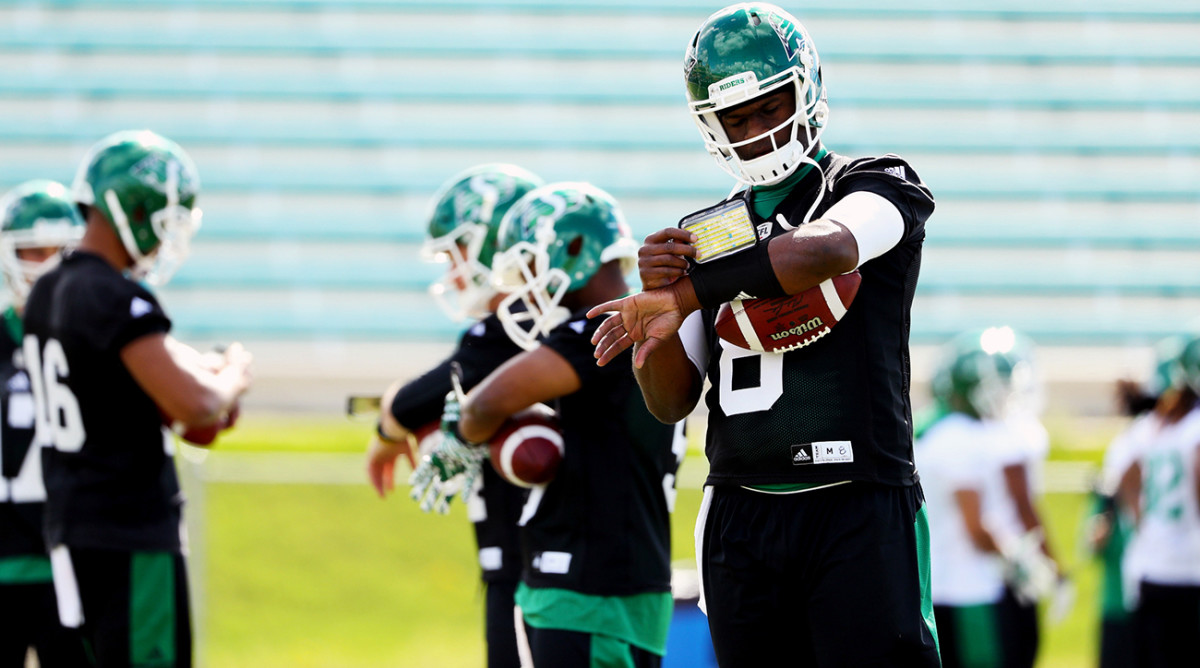
One week before Super Bowl LI, last February, two men who knew much about fame achieved and fortune squandered met in Houston: Young and agent Leigh Steinberg, who in 2014 began representing clients again after filing for bankruptcy and undergoing rehab for alcoholism. The two men spoke for four hours, baring their souls into the early morning.
Steinberg listened as Young talked about how he’d clawed back from financial calamity, started three businesses, taken on two jobs; about how he was happily married, living in the place where he was most celebrated; about how he wanted to play football again . . . in the CFL. Come again? With a contract that would pay just over $100,000 per season, Steinberg had the same question as everyone else: Why? Finishing his career as a CFL backup, an utterly unremarkable -ending—was that any better than getting canned by the lowly Browns? “Yes,” Young answered, and Steinberg, at that point, bought in.
In March, the duo traveled to Saskatchewan for Young’s first press conference. And while Steinberg’s teeth chattered in the –20° temperatures, Young’s poise in front of the Canadian press signaled to his confidants how far he’d come. He dedicated his comeback to Cuyler Duncan, a UT friend who’d died from cancer earlier that month, and he deftly handled a series of fair but tough questions about his motivation for playing in the CFL. In front of a packed room he took full responsibility for his failures, laughed at his notoriety and shrugged off the fact that the Roughriders’ number 10 jersey, which he’d worn since childhood, already belonged to another player. “A lot of people hadn’t heard from me in a while,” Young says. “Everybody was like, Where’s Vince? I’m living, enjoying life. I wanted that to come across.”
Here was Young, right away, trading text messages in a group thread with his fellow quarterbacks, none of them with a lick of NFL experience. He leaned on Kevin Glenn, a 17-year veteran (and his main competition for reps), for advice. He did all the right things, said all the right things.
There was one problem.
He was 34 and hadn’t played quarterback in three years.
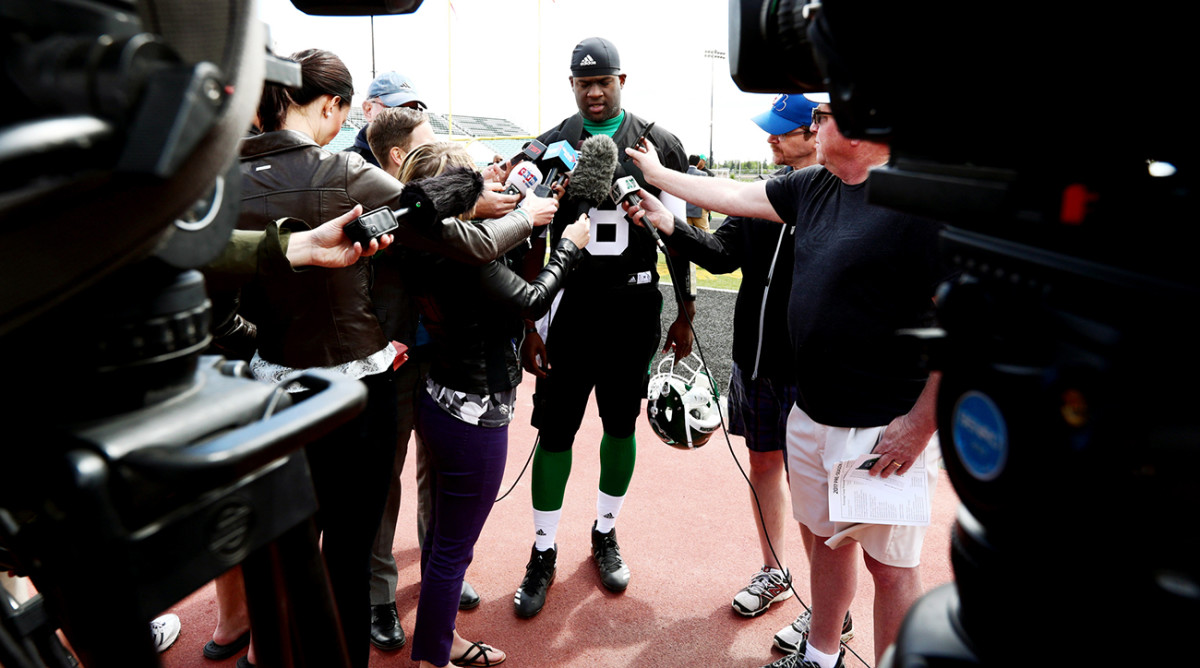
As spring turns into summer, Young progresses and stalls and progresses again. Every day back on the field he’s one step further from Tennessee and Cleveland, one step closer to a new end. He looks sharper in his new offense one day and then tosses three interceptions the next. Worse yet, in the second week of camp he injures his left hamstring in practice, not a surprising injury given his age and his long break from the game.
Back in his dorm room Young tells me that his past mistakes made him stronger, more capable, gave him a better story to share in schools. Still, if he’s being honest, he bristles when pundits describe his career as mediocre. One recent NFL Network video referred to his six pro seasons and two Pro Bowl appearances as a “tease,” and he says he wanted to tell them, “Check my résumé.”
Having lived through that and several TMZ tsunamis, Young then chooses a peculiar superstar to identify with. He points to Tiger Woods as one of the few people on earth who can fully understand his life. The two superstars met after that 2006 Rose Bowl, at the MGM Grand Casino in Las Vegas, and then saw their careers collapse at roughly the same time. Now they’re both closer to the end than they are to their halcyon days, trying to make sense of the fall.
The week I’m in Canada, Woods is arrested for driving under the influence (later revealed to be tied to prescription painkillers), and Young brings up the incident, umprompted. “Tiger made a mistake,” he says. “How can anyone say they know what he’s going through? He’s probably f------ down [that] he can’t play golf. But [the media] wants to make an example out of him. Judges, lawyers, all kinds of people get DWIs.”
Young himself was arrested in January 2016 and pleaded no contest to driving while intoxicated after he was pulled over in Austin with a blood-alcohol level (.246) more than three times the legal limit. As part of his plea he had to perform 60 hours of community service, pay a $300 fine and spend 18 months on probation. Young says he felt horrible for his family. He issued an apology on Facebook but didn’t feel that it was accepted by the public. He thought back to advice he’d received from Kobe Bryant in ’09, when the Lakers legend told him to “do you” and “don’t give a s--- about those that judge you.” But Young found it wasn’t easy, not caring. He could turn off the TV and ignore the headlines, but he couldn’t disappear forever. One day after his DWI he was scheduled to give a speech as part of UT’s African American Male Research Initiative. He considered backing out; he felt “like a hypocrite.” But Candice told him to go: “You need to show them that when you make a mistake, you stand up and you own it.”
In the time I spent with Young, it seemed he most wanted for people to see him and his NFL career the way that he sees them. He had spent the first half of his life becoming famous and the second half wrestling with the consequences of that fame. He longed to be respected for his accomplishments, given the due he earned. He hated how his name had been used as a punch line, his career forgotten in some places. And he appeared so vulnerable in those moments, so human, wishing for what we all wish for—recognition, appreciation, reverence. Life in public view rarely works like that, of course. There’s then and there’s now.
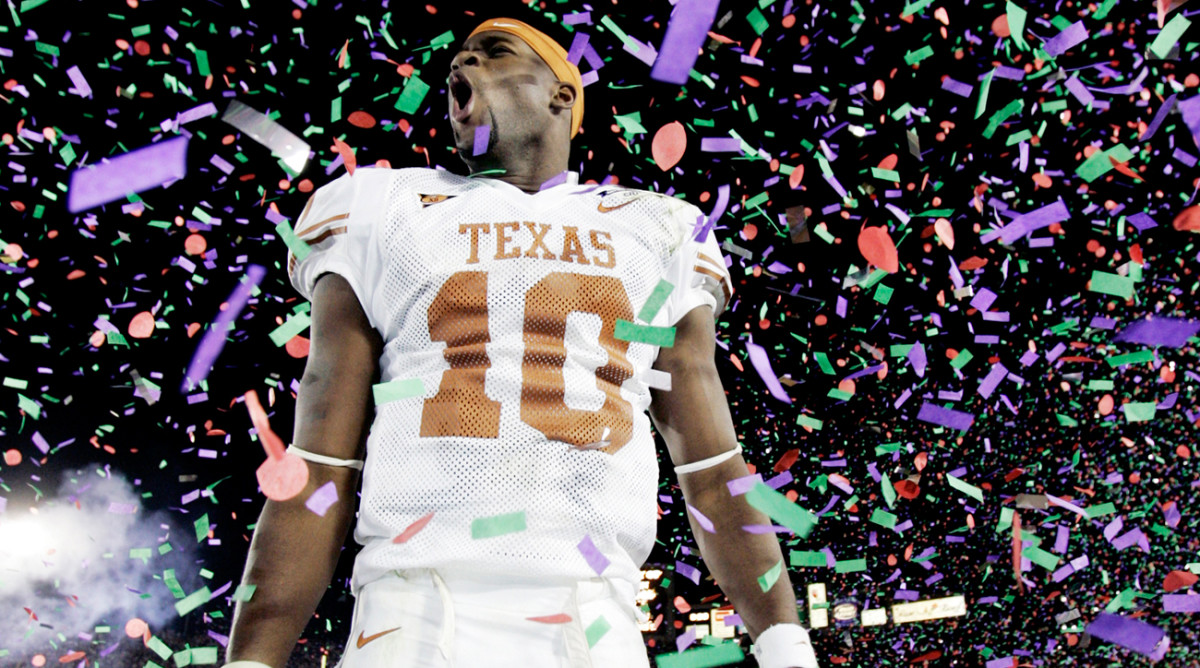
It’s late June and Vince Young is back in Austin, his comeback having ended on a routine play when he was scrambling under pressure. An MRI revealed a tear, and although initial reports indicated he’d been released, the Roughriders actually placed Young on their retired list. They still own his CFL rights.
For all the skepticism that followed him to Canada, Young remains consistent in his messaging: He came back because he loved the game, he says, and he wanted to play free of the mess that he believes ended his NFL career. He admired the fans in Saskatoon so much that he’s considering opening up another steak house there. “I was having a blast,” he says. “A lot of people don’t understand: The best part of sports is the camaraderie. I’m blessed I was able to be around those guys.” The last time he felt that free on the field was during year two as a Titan.
It stings, of course, this ending. Young wishes his teammates good luck and jets to Cozumel, Mexico, by himself, shutting off his cellphone for four days, ignoring emails. He plays golf and fishes and prays, processing another imperfect conclusion. Then he decides he’ll continue rehabbing his injury. One minute, he says he’s moving toward acceptance, ready to move on. The next. . . .
“Maybe I’ll play football again,” he says. “You never know.”
